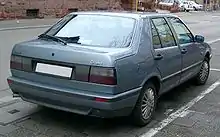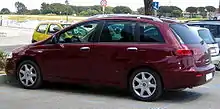| Fiat Croma | |
|---|---|
 | |
| Overview | |
| Manufacturer | Fiat |
| Production | 1985–1996 2005–2010 |
| Body and chassis | |
| Class | Large family car (D) |
| Layout | Front-engine, front-wheel-drive |
| Chronology | |
| Predecessor | Fiat Argenta (as sedan) |
| Successor | Fiat Freemont |
The Fiat Croma name was used for two distinct large family cars by Fiat, one a five door liftback manufactured and marketed from 1985 to 1996, and after a nine-year hiatus, a crossover station wagon manufactured and marketed from 2005 to 2010.
First generation (1985–1996)
| First generation (154) | |
|---|---|
 First facelift model (1988–1991) | |
| Overview | |
| Production | 1985–1996 |
| Assembly | Mirafiori, Turin, Italy |
| Designer | Giorgetto Giugiaro at Italdesign |
| Body and chassis | |
| Body style | 5-door liftback |
| Platform | Type Four platform (Tipo Quattro)[1] |
| Related | Saab 9000 Lancia Thema Alfa Romeo 164 |
| Dimensions | |
| Wheelbase | 2,660 mm (104.7 in) |
| Length | 4,495 mm (177.0 in) |
| Width | 1,755 mm (69.1 in) |
| Height | 1,425 mm (56.1 in) |
| Curb weight | 1,095 kg (2,414 lb) approx |
| Chronology | |
| Predecessor | Fiat Argenta |

The original Croma (Type 154) was a five door notchback liftback styled by Giorgetto Giugiaro of Italdesign using the Type Four platform, cooperatively used with the Saab 9000, Lancia Thema and Alfa Romeo 164.[2]
Released in December 1985, it was marketed in the large family car segment, replacing the Argenta in the Fiat lineup. The Croma was the first large car produced by Fiat to feature a transverse mounted engine and front wheel drive.[3]
Facelift


The Croma received a light facelift for 1988, first shown in Frankfurt in September 1987. The black plastic between the rear lamps was now ridged rather than smooth, the lower portion of the bumpers were body coloured, and the turn signals received clear glass rather than amber.[4]
The front appearance received some other light modifications to bring appearance in line with that of the recently introduced Tipo.[5]
A more significant facelift was released in January 1991, with a new front design, including changes to the lights, bumpers grille and sheet metal changes to wings and bonnet. Also in 1991, the direct injected diesel engine was equipped with a variable geometry turbocharger ("VNT").[6] Another facelift was released in June 1993.
Production ended in December 1996, and Fiat left the large family car segment. The Bravo/Brava based Fiat Marea small family car debuted at the same time as the Croma's cancellation.
Engines
The Croma was available with a variety of petrol and diesel engines, most of the petrol units coming from Fiat's Twin Cam engine family.
Base models had a single cam 1585 cc four with 83 hp (61 kW) and the 1995 cc, 90 hp (66 kW) "Controlled High Turbulence" (CHT) engine, followed by two fuel injected 2.0 litre twin cam powerplants, one with 120 hp (88 kW) and the other a turbocharged and intercooled version giving 155 hp (114 kW).
The later 2.5 L V6 petrol unit was from Alfa Romeo, but as with the 1.6 L engine it was not available in all markets. The 2.0 CHT was designed specifically to provide low fuel consumption under light and medium loads thanks to two separate inlet manifolds of different diameters.[7]
The Fiat Croma was the first passenger car in the world to have a direct injection Diesel (Turbo D i.d.) engine, going on sale in 1988.[5][8] The 1.9 L fitted with a turbocharger with direct injection produces 92 hp (68 kW). It was joined by the 2499 cc unit supplied by Iveco, with a normally aspirated version giving 75 hp (55 kW) and a turbocharged one with 115 hp (85 kW). The latter version replaced the original 2446 cc with 100 hp (74 kW).
Diesel engined variants of this car were not marketed in the United Kingdom.
Petrol
Diesel
|
Second generation (2005–2010)
| Second generation (194) | |
|---|---|
 | |
| Overview | |
| Production | 2005–2010 (LHD)[9] 2005–2007 (RHD) |
| Assembly | Cassino – Piedimonte S. Germano (Frosinone), Italy |
| Designer | Giorgetto Giugiaro at Italdesign |
| Body and chassis | |
| Body style | 5-door MPV |
| Platform | GM Epsilon platform |
| Related | Cadillac BLS Opel Signum Opel Vectra Saab 9-3 |
| Powertrain | |
| Transmission | 5- and 6-speed manual 6-speed automatic |
| Dimensions | |
| Wheelbase | 2,700 mm (110 in) |
| Length | 4,755 mm (187.2 in) 4,783 mm (188.3 in) (facelift) |
| Width | 1,775 mm (69.9 in) |
| Height | 1,600 mm (63 in) |
| Chronology | |
| Successor | Fiat Freemont |

In March 2005, Fiat announced a large crossover wagon with an upright tailgate, reminiscent of that of the Fiat Stilo, resurrecting the Croma nameplate. Giugiaro once again styled the exterior, while the chassis was provided via the short lived link with General Motors.
The new Croma (Type 194) is therefore based on the extended variant of the GM Epsilon platform sharing components with the Opel Vectra, Opel Signum and Saab 9-3. It went on sale in Italy in June 2005. The car was shown in the Geneva Motor Show in 2005.
Unlike the previous model, and aware of its lack of image in the upper market segments, Fiat opted for not developing a standard large family car, but developing a "Comfort Wagon",[10] an automobile with design elements of both estates and large MPVs.
Its height of 1,600 mm (63.0 in) falls between the Mitsubishi Grandis and Ford S-Max large MPVs (1,655 mm (65.2 in) and 1,660 mm (65.4 in) respectively) and SEAT Altea XL (1,525 mm (60.0 in)). In February 2007, Fiat UK announced that the Croma would no longer be generally available in the United Kingdom, after less than 900 were sold in 2005.
The car was still offered, but only on special order, with RHD models manufactured to customer specifications. Production of the second generation Croma ceased in the end of 2010 and was replaced by the Dodge-based Fiat Freemont.
Safety
The Croma has seven airbags as standard, including one knee bag for the driver. As standard, the Croma is equipped with anti-lock braking system and electronic brakeforce distribution. It has a five star Euro NCAP crash rating for adult occupant protection:
| Test | Score | Rating |
|---|---|---|
| Adult occupant: | 34 | |
| Child occupant: | 39 | |
| Pedestrian: | 6 |
Facelift

The Croma got a major facelift in November 2007, and was termed the Nuova Croma. A new grille (Bravo look) and rear bumper, as well as some material changes inside are the main differences. Fiat now designates the revised model as "Station Wagon" instead of the previously used term "Comfort Wagon".[11] The Nuova Croma was only sold in mainland Europe, excluding the United Kingdom.
Engines
The Croma, built at Fiat's Cassino factory, had three trim levels and five engine options. Like the chassis, petrol engines were supplied by Opel, beginning with the brand new evolution of the Family 1 Ecotec 1.8 L with 140 hp (103 kW), followed by the torquier L850 Ecotec 2.2 L with 147 hp (108 kW).
However, the bulk of the sales is represented by Fiat's own Multijet engine, available in three variants 1.9 L with 8 valves and 120 hp (88 kW), 1.9 L with 16 valves and 150 hp (110 kW), and the range topping, five-cylinder 2.4 L 20V with 200 hp (147 kW). The diesel engines were fitted with a standard six-speed manual gearbox, a six-speed automatic was also available and was standard fitment on the 2.4 engines.
Petrol
| Model | Engine | Displacement | Power | Torque |
|---|---|---|---|---|
| 1.8 MPI 16V | DOHC 16V I4 | 1796 cc | 140 hp (103 kW) at 6300 rpm | 175 N⋅m (129 lb⋅ft) at 3800 rpm |
| 2.2 MPI 16V | DOHC 16V I4 | 2198 cc | 147 hp (108 kW) at 5800 rpm | 203 N⋅m (150 lb⋅ft) at 4000 rpm |
Diesel
| Model | Engine | Displacement | Power | Torque |
|---|---|---|---|---|
| 1.9 MultiJet 8V | SOHC 8V I4 | 1910 cc | 120 hp (88 kW) at 4,000 rpm | 280 N⋅m (207 lb⋅ft) at 2,000 rpm |
| 1.9 MultiJet 16V | DOHC 16V I4 | 1910 cc | 150 hp (110 kW) at 4,000 rpm | 320 N⋅m (236 lb⋅ft) at 2,000 rpm |
| 2.4 MultiJet 20V | DOHC 20V I5 | 2387 cc | 200 hp (147 kW) at 4,000 rpm | 400 N⋅m (295 lb⋅ft) at 2,000 rpm |
References
- ↑ "Curiosidades Tipo". Fiat Tipo Portugal. Archived from the original on 5 March 2012. Retrieved 30 December 2013.
- ↑ "Octane Model Specs". Classicandperformancecar.com. Archived from the original on 11 March 2012. Retrieved 1 August 2012.
- ↑ Autocar Test Update 19 August 1987
- ↑ Baghetti, Giancarlo (17 December 1987). "Che diesel volete?" [Which diesel do you want?]. Auto Oggi (in Italian). Verona, Italy: Arnoldo Mondadori Editore. 2 (54): 19.
- 1 2 Mastrostefano, Raffaele, ed. (January 1989). "Le nostre "stelle"" [Our "stars"]. Quattroruote (in Italian). Vol. 34, no. 399. Milan, Italy: Editoriale Domus. pp. 90–91.
- ↑ "Turbo Pioneer". honeywell.com. Retrieved 22 January 2014.
- ↑ Letrou, Jean-Claude (January 1986). "Fiat Croma: En quête d'image" [On a quest for image]. L'Automobile Magazine (in French). Neuilly-sur-Seine, France: Societé des Editions Techniques et Touristiques de France: 34. ISSN 0758-6957.
- ↑ "Air technologies - Heritage". fiat.com. Archived from the original on 8 August 2013.
- ↑ "Fiat Croma uit productie; het einde van een tijdperk". autoedizione.nl (in Dutch). Retrieved 6 April 2011.
- ↑ Car Reviews: First Drives: Fiat Croma - Autoexpress
- ↑ "Nuova Fiat Croma". italiaspeed.com. Retrieved 13 November 2007.
.svg.png.webp)